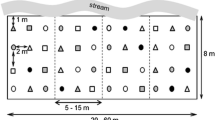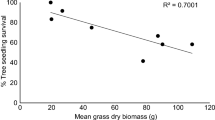Abstract
This study aimed at evaluating alternative methods to ensure regeneration success in temperate low-mountain forest stands by (1) estimating the effects of seed availability, competition from the adult stand and from neighbouring vegetation and interaction with the litter layer on seedling density, and by (2) comparing the effects of various silvicultural methods on regeneration success. The experiment was conducted in a monospecific beech (Fagus sylvatica) stand and a mixed silver fir-beech (Abies alba, Fagus sylvatica) stand with contrasted vegetation communities, in north-east France. Different methods of soil preparation, i.e. chemical (herbicide), mechanical (surface hoeing and deep scarification using light-weight machines) and biological (cover crops after surface hoeing) methods, were applied along a canopy opening gradient. After soil preparation (in 2009), vegetation colonisation and tree seedling density were monitored once a year from 2010 to 2013. Results were similar for the two sites. Seedling density the first year indicated a predominant effect of seed availability and soil scarification over potential competitive effects of adult stand and neighbouring vegetation. Despite continuous vegetation colonisation after soil preparation, seedling density remained stable over the 4 years of the experiment. For each of the 4 years, seedling density increased with canopy cover. Seedling density was higher after mechanical soil preparation than after herbicide application. Cover crops (following surface hoeing) appeared as the best method, ensuring both the lowest vegetation colonisation and the highest seedling density.




Similar content being viewed by others
References
Adam B, Benoït JC, Balandier P, Marquier A, Sinoquet H (2006) PiafPhotem—software to threshold hemispherical photographs. UMR PIAF INRA-UBP, Alliance vision, Clermont-ferrand
Amm A, Pichot C, Dreyfus P, Davi H, Fady B (2012) Improving the estimation of landscape scale seed dispersal by integrating seedling recruitment. Ann For Sci 69:845–856. doi:10.1007/s13595-012-0208-1
Ammer C, Balandier P, Bentsen NS, Coll L, Lof M (2011) Forest vegetation management under debate: an introduction. Eur J For Res 130:1–5. doi:10.1007/s10342-010-0452-6
Ampoorter E, De Schrijver A, De Frenne P, Hermy M, Verheyen K (2011) Experimental assessment of ecological restoration options for compacted forest soils. Ecol Eng 37:1734–1746. doi:10.1016/j.ecoleng.2011.07.007
Balandier P, Collet C, Miller JH, Reynolds PE, Zedaker SM (2006) Designing forest vegetation management strategies based on the mechanisms and dynamics of crop tree competition by neighbouring vegetation. Forestry 79:3–27. doi:10.1093/forestry/cpi056
Balandier P, Frochot H, Sourisseau A (2009) Improvement of direct tree seeding with cover crops in afforestation: microclimate and resource availability induced by vegetation composition. For Ecol Manage 257:1716–1724. doi:10.1016/j.foreco.2009.01.032
Boyes LJ, Gunton RM, Griffiths ME, Lawes MJ (2011) Causes of arrested succession in coastal dune forest. Plant Ecol 212:21–32. doi:10.1007/s11258-010-9798-6
Brunner A (1999) Hemispherical photography and image analysis with hemlMAQE and Adobe® Photoshop®
Clark JS et al (1999) Interpreting recruitment limitation in forests. Am J Bot 86:1–16. doi:10.2307/2656950
Comas C, Mateu J (2007) Modelling forest dynamics: a perspective from point process methods. Biom J 49:176–196. doi:10.1002/bimj.200510268
de Chantal M, Leinonen K, Ilvesniemi H, Westman CJ (2003) Combined effects of site preparation, soil properties, and sowing date on the establishment of Pinus sylvestris and Picea abies from seeds. Can J For Res 33:931–945. doi:10.1139/x03-011
Dodet M, Collet C, Frochot H, Wehrlen L (2011) Tree regeneration and plant species diversity responses to vegetation control following a major windthrow in mixed broadleaved stands. Eur J For Res 130:41–53. doi:10.1007/s10342-010-0406-z
Evans G, Coombe D (1959) Hemispherical and woodland canopy photography and the light climate. J Ecol 47:103–113
Gaudio N, Balandier P, Marquier A (2008) Light-dependent development of two competitive species (Rubus idaeus, Cytisus scoparius) colonizing gaps in temperate forest. Ann For Sci 65. doi:10.1051/forest:2007076
Gaudio N, Balandier P, Philippe G, Dumas Y, Jean F, Ginisty C (2011) Light-mediated influence of three understorey species (Calluna vulgaris, Pteridium aquilinum, Molinia caerulea) on the growth of Pinus sylvestris seedlings. Eur J For Res 130:77–89. doi:10.1007/s10342-010-0403-2
Gégout JC, Rameau JC, Renaux B, Jabiol B, Bar M, Marage D (2008) Les habitats forestiers de la France tempérée—typologie et caractérisation phytoécologique. AgroParisTech-ENGREF, Nancy. 720 pp
Granhus A, Hanssen KH, de Chantal M (2008) Emergence and seasonal mortality of naturally regenerated Picea abies seedlings: impact of overstory density and two site preparation methods. New For 35:75–87. doi:10.1007/s11056-007-9061-8
Harvey B, Brais S (2002) Effects of mechanized careful logging on natural regeneration and vegetation competition in the southeastern Canadian boreal forest. Can J For Res 32:653–666. doi:10.1139/x02-006
Holub SM, Terry TA, Harrington CA, Harrison RB, Meade R (2013) Tree growth ten years after residual biomass removal, soil compaction, tillage, and competing vegetation control in a highly-productive Douglas-fir plantation. For Ecol Manage 305:60–66. doi:10.1016/j.foreco.2013.05.031
Klein EK, Bontemps A, Oddou-Muratorio S (2013) Seed dispersal kernels estimated from genotypes of established seedlings: does density-dependent mortality matter? Methods Ecol Evol 4:1059–1069. doi:10.1111/2041-210x.12110
Löf M, Welander NT (2004) Influence of herbaceous competitors on early growth in direct seeded Fagus sylvatica L. and Quercus robur L. Ann For Sci 61:781–788. doi:10.1051/forest:2004075
Löf M, Dey DC, Navarro RM, Jacobs DF (2012) Mechanical site preparation for forest restoration. New For 43:825–848. doi:10.1007/s11056-012-9332-x
Manso R, Pardos M, Keyes CR, Calama R (2012) Modelling the spatio-temporal pattern of primary dispersal in stone pine (Pinus pinea L.) stands in the Northern Plateau (Spain). Ecol Model 226:11–21. doi:10.1016/j.ecolmodel.2011.11.028
McCarthy N, Bentsen NS, Willoughby I, Balandier P (2011) The state of forest vegetation management in Europe in the 21st century. Eur J For Res 130:7–16. doi:10.1007/s10342-010-0429-5
Messier C, Doucet R, Ruel JC, Claveau Y, Kelly C, Lechowicz MJ (1999) Functional ecology of advance regeneration in relation to light in boreal forests. Can J For Res 29:812–823. doi:10.1139/cjfr-29-6-812
Örlander G, Gemmel P, Hunt J (1990) Site preparation: a Swedish overview. In: FRDA report, vol 105. BC Ministry of Forests, Victoria, Canada, p vi + 62 pp
Picard N, Bar-Hen A, Mortier F, Chadoeuf J (2009) Understanding the dynamics of an undisturbed tropical rain forest from the spatial pattern of trees. J Ecol 97:97–108. doi:10.1111/j.1365-2745.2008.01445.x
R Development Core Team (2011) R: a language and environment for statistical computing. R Foundation for Statistical Computing, Vienna, Austria
Reinecke H (2000) Begleitwachsregulierung. Reinecke Forstservice, Göttingen
Sefidi K, Mohadjer MRM, Mosandl R, Copenheaver CA (2011) Canopy gaps and regeneration in old-growth Oriental beech (Fagus orientalis Lipsky) stands, northern Iran. For Ecol Manage 262:1094–1099. doi:10.1016/j.foreco.2011.06.008
Solarik KA, Lieffers VJ, Volney WJA, Pelletier R, Spence JR (2010) Seed tree density, variable retention, and stand composition influence recruitment of white spruce in boreal mixedwood forests. Can J For Res 40:1821–1832. doi:10.1139/x10-125
Thiffault N, Jobidon R (2006) How to shift unproductive Kalmia angustifolia—Rhododendron groenlandicum heath to productive conifer plantation. Can J For Res 36:2364–2376. doi:10.1139/x06-090
Thiffault N, Roy V (2011) Living without herbicides in Quebec (Canada): historical context, current strategy, research and challenges in forest vegetation management. Eur J For Res 130:117–133. doi:10.1007/s10342-010-0373-4
van Couwenberghe R, Collet C, Lacombe E, Pierrat JC, Gegout JC (2010) Gap partitioning among temperate tree species across a regional soil gradient in windstorm-disturbed forests. For Ecol Manage 260:146–154. doi:10.1016/j.foreco.2010.04.013
van Couwenberghe R, Collet C, Lacombe E, Gegout JC (2011) Abundance response of western European forest species along canopy openness and soil pH gradients. For Ecol Manage 262:1483–1490. doi:10.1016/j.foreco.2011.06.049
Wagner RG, Little KM, Richardson B, McNabb K (2006) The role of vegetation management for enhancing productivity of the world’s forests. Forestry 79:57–79. doi:10.1093/forestry/cpi057
Wagner S, Fischer H, Huth F (2011) Canopy effects on vegetation caused by harvesting and regeneration treatments. Eur J For Res 130:17–40
Wang BC, Smith TB (2002) Closing the seed dispersal loop. Trends Ecol Evol 17:379–385. doi:10.1016/s0169-5347(02)02541-7
Willoughby I, Balandier P, Bentsen NS, Mc Carthy N, Claridge J (2009) Forest vegetation management in Europe: current practice and future requirements. COST Office, Brussels, COST Action E47, 157 pp
Acknowledgments
The authors thank Léon Wehrlen for stimulating discussions, Erwin Thirion and Florian Vast for running the experiment and establishing the database, Vanessa Vilard for data preprocessing, and Xavier Auzuret and Fabien Duez for field work and data collection. This research was funded by the Ministère de l’Agriculture, de l’Agroalimentaire et de la Forêt (MAAF) through the programs E 30/07 and E 16/2011 and by the Office National des Forêts (ONF) through the programs “Maîtrise de la végétation forestière concurrente 2007–2010, and 2011–2014”. The UMR 1092 LERFoB is supported by the French National Research Agency (ANR) through the Laboratory of Excellence ARBRE (ANR-12-LABXARBRE-01).
Conflict of interest
The authors declare that they have no conflict of interest.
Author information
Authors and Affiliations
Corresponding author
Additional information
Communicated by C. Ammer.
Rights and permissions
About this article
Cite this article
Dassot, M., Collet, C. Manipulating seed availability, plant competition and litter accumulation by soil preparation and canopy opening to ensure regeneration success in temperate low-mountain forest stands. Eur J Forest Res 134, 247–259 (2015). https://doi.org/10.1007/s10342-014-0847-x
Received:
Revised:
Accepted:
Published:
Issue Date:
DOI: https://doi.org/10.1007/s10342-014-0847-x




